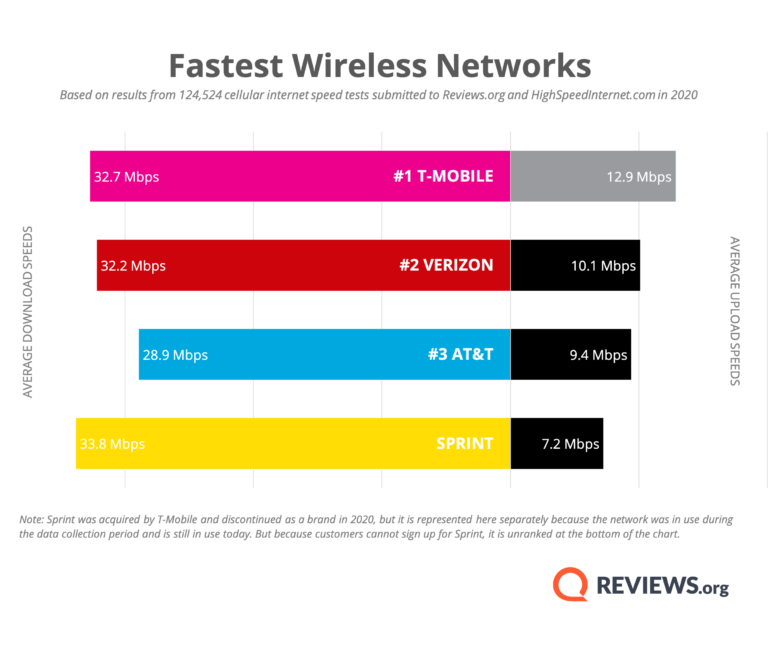T-Mobile boasts the fastest data speeds in the industry and offers tons of perks. But it’s pricey (unless you get a family plan). Meanwhile, Reach’s plans are generally cheaper and have an awesome charitable aspect. But its data speeds and data caps are much lower than T-Mobile’s. So, in general, T-Mobile is the best choice for those that want high performance. And Reach is best for those who want to save money and give something back. We’ll go over all the nitty-gritty details below—from plans and pricing to coverage and perks.
Data: Having enough high-speed data is essential for streaming, gaming, and working on your phone. Be sure you have the data you need (even unlimited plans have data caps, so read the fine print). Price: You can avoid overpaying by comparing prices. Use tools like the WhistleOut widgets in this article to ensure you’re getting the best price available. Coverage: AT&T, T-Mobile, and Verizon are all competing to create the best network. Look at their maps to see which one has the best coverage in your area. Features: Special features —like hotspot data, international benefits, and HD video streaming—don’t usually come standard. Make sure your plan has the pens you need.
This chart from WhistleOut shows the prices and features of each plan. While that’s $65 a month for an unlimited data plan is totally within the normal range, it’s hardly a spectacular deal, especially when you consider Reach’s problems with data caps and deprioritization … Once users hit that cap, their data speeds can be dramatically reduced. Basic tasks like streaming audio and conducting Zoom meetings can become difficult at that point. But Reach’s data woes don’t end there. The company is a mobile virtual network operator (MVNO), which means it doesn’t own its own cellular network. Instead, it rents bandwidth from Verizon, and that means Reach customers will always be at risk of data deprioritization. Customers can use the Reach Mobile app to track their impact. You can see just how many people you’ve helped and how much talk, text, and data you’ve contributed through your account.
Essentials: This plan comes with the risk of deprioritization, meaning that your data speeds can be slowed down at any time. It also has a 50 GB data cap. If you go beyond that you’ll see significant data slowdowns. Magenta: This plan gives you 5 GB of high-speed 4G LTE hotspot data and has a super-high data cap of 100 GB per month (most users won’t go above that). Magenta MAX: This one has it all. It comes with 40 GB of hotspot data, worldwide data coverage, 4K video streaming, a free Netflix subscription, and no data cap!
All of these plans will (obviously) put you on T-Mobile’s network. That means you’ll enjoy the fastest 4G speeds in the industry. We surveyed over 100,000 mobile customers to get the statistics in this chart. Those of you who want a limited-data plan with just a few GB of data will find a better deal with Reach. Plus, you’ll get the satisfaction of knowing that some of your money is going to help others! So, what’s the big deal with T-Mobile? Well, besides the little perks they throw in when you add extra lines (like free Netflix subscriptions), the company gives you incredible discounts. This chart shows how much each of T-Mobile’s unlimited plans cost with four lines. But the best way to see which carrier has the best coverage in your area is to look at the maps. T-Mobile’s most popular deals are for flagship phones, like the Samsung Galaxy S20 and the iPhone 12. Reach, meanwhile, is more focused on discount devices, like the iPhone SE (2020). Take a look at the specific promotional deals each company offers right now in these charts.
Plans: T-Mobile’s unlimited data plans are powerhouses that give you everything, from super-fast data to amazing perks. Reach’s plans are cheaper—and they’re charitable—but they can’t compete when it comes to overall performance. Family plans: Reach Mobile doesn’t really offer anything in terms of family plans. T-Mobile, meanwhile, has some of the best deals on the market. You can save hundreds of dollars by bundling lines on a single account. Coverage and performance: Reach Mobile wins in the coverage category. But T-Mobile’s coverage isn’t bad, and its network speeds are incredible. These data speeds plus T-Mobile rapidly expanding 5G network make it the better carrier for overall performance.
We then looked at customer reviews and our own data from over 100,000 mobile customers to compare the data speeds, coverage, and consistency of Reach and T-Mobile. This helped us evaluate the overall performance of each carrier. Overall, we put over a dozen hours into researching and writing this in-depth review. If you want to know more about our process you can read our article about how we rate cell phone plans.

